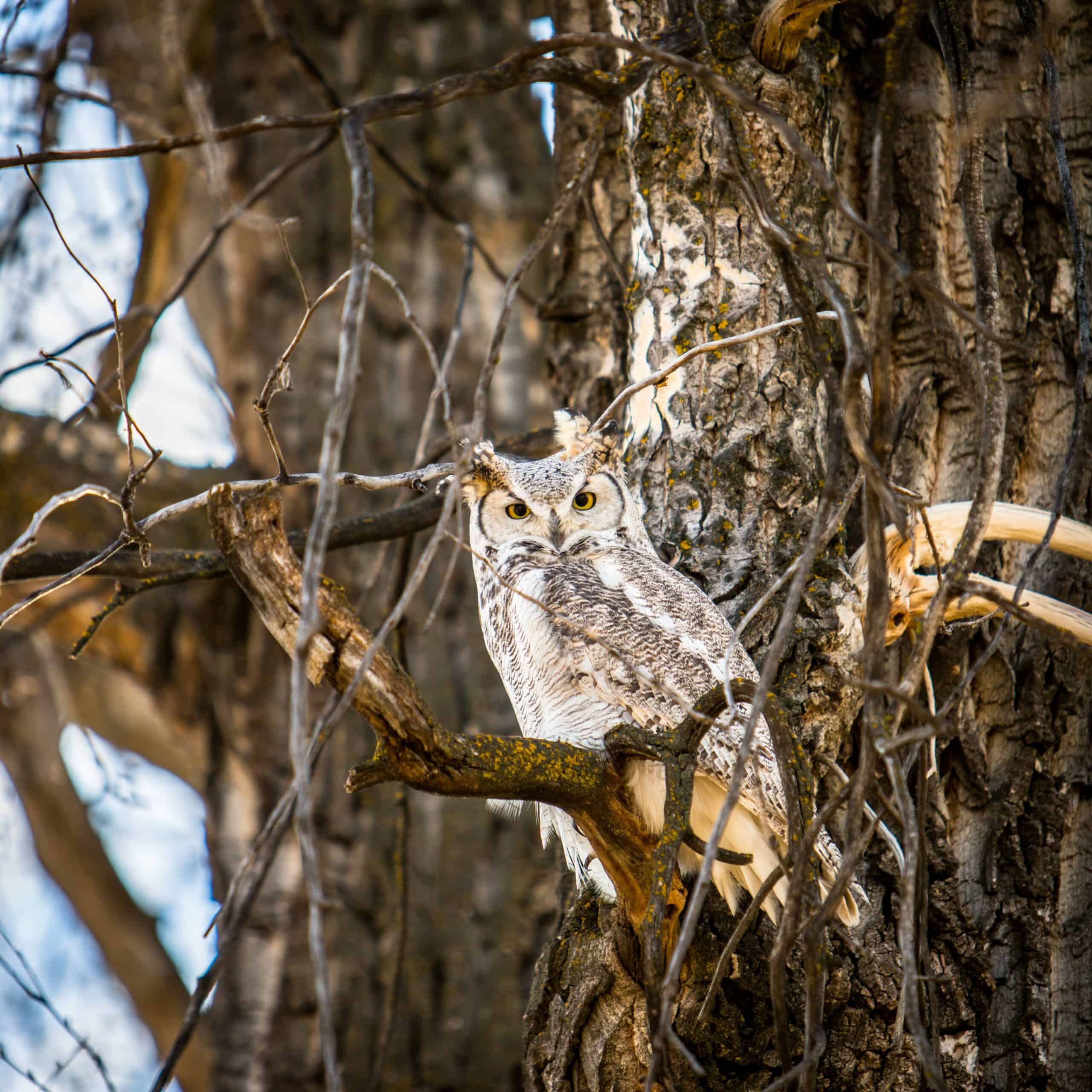Learn about different types of owls. With their unique calls and their nocturnal habits, owls are very fascinating birds. Because they feast on rodents, snakes, and other small creatures, owls are considered apex predators.
Despite the fact that some people find them spooky, their eating habits help keep the population of pesky animals in check. They can be a great asset to your property.
Owls are found almost everywhere, and they vary greatly in shape, size, and habits. Wherever you live in the United States, Canada, or Mexico, chances are that different types of owls are living nearby. Here are some of the most common types of owls found in North America.
Different Types of Owls
1. Great Horned Owl
Any place that has trees and rocky nesting sites in the United States will be a home to a Great Horned owl. Their habitat covers every part of the North American continent, making them one of the most adaptable owls. These owls are mostly nocturnal. Due to their large size, they are not cavity nesters. If you are interested in learning how to attact owls, particularly the Great Horned owl, they are too large for nesting boxes.
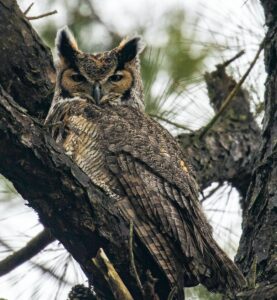
Great Horned owls have tufts of feathers standing erect on their heads, giving them the appearance of having horns. Great Horned owls are one of the largest owls in North America. They are fierce predators and can attack larger animals, including owls and other raptors. They will also eat snakes and mice, ducks, geese, and rabbits.
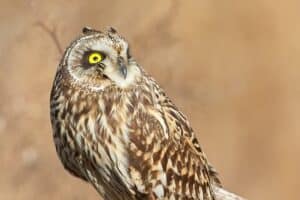
2. Short Eared Owl
Short Eared owls are found in the Northeastern portions of the United States, although their breeding grounds are sometimes in places as far north as Alaska and in Northern Canada. A few groups of Short Eared owls will travel as far south as Mexico for winter. These birds love flat farmland and open plains, flying low over the ground as they hunt for prey.
There is a subspecies of Short Eared owls called the Pueo owl. The Pueo is an owl species native to Hawaii. However, their numbers are dwindling.
Short Eareds are crepuscular, meaning that they are active during both day and night. They are savage eaters, removing the heads and viscera of their prey before eating the rest of it. They eat small mammals and birds.
These owls build their nests on the ground in open areas. They will try to lure predators away from the nest by flopping around nearby, pretending to be injured. When a Short Eared owl calls, it sounds like a cat in heat.
3. Spotted Owl
The Spotted owl has three different subspecies in North America:
- Northern Spotted owl
- California Spotted owl
- Mexican Spotted owl- This owl type is found in the Southwestern United States as well as in Mexico.
These owls are losing habitat fast, because they prefer mature forests of the West. Thanks to fires and the cutting of mature trees, their habitat is shrinking and cannot be quickly replaced. These owls are found in isolated pockets in the West.
Spotted owls re-use the nests of other birds, never building their own. Another reason that their numbers are declining is that they may not necessarily raise young every year, although they do mate for life.
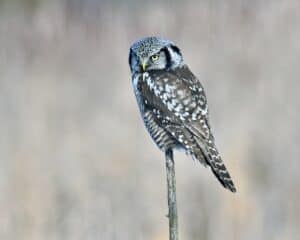
4. Northern Hawk Owl
Northern Hawk owls actually behave more like hawks than owls. This owl species of the extreme north likes to sit atop tall structures and hunt during the day, a trait that makes them stand out in the world of owls. They locate their prey by sight and do not have hearing that is as acute as many other kinds of owls.
Northern Hawk owls are generally found only in Alaska and Canada, but you might find them in some extreme northern states like New York or Minnesota in the winter. They generally are found in mature, dense forests.
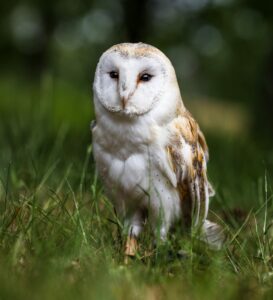
5. American Barn Owl
American Barn owls not only have the amazing vision that most owls are known for, but they also have incredible hearing. They have the unbelievable skill of locating prey by sound alone!
The American Barn owl lives in man-made structures like barns, silos, sheds, or outbuildings. They do not migrate, but stay in place all year long.
While they don’t care for the mountains, you can find them all over the North American continent in places where there are open fields and farmland. Barn owls are one of the two types of owls found in Hawaii. They are not native but were introduced to the islands.
American Barn owls are medium-sized owls with a striking appearance. They have white faces with other colors on the body. Their faces are shaped like a heart. These owls are nocturnal hunters, and therefore, not much of a threat to pets like chickens or ducks unless they aren’t penned up securely.
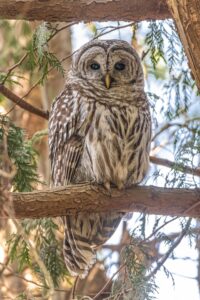
6. Barred Owl
Barred owls are named for the alternating horizontal stripes of dark and light brown on the animal’s body. These owls are very curious and less fearful than many other kinds of owls. They will observe you as much as you try to observe them. If you hear a call at night that sounds like “Who cooks for you?” you definitely have a barred owl in the area.
These owls are second in size only to the Great Horned owl, so they eat pretty much any animal that is smaller than themselves. Historically, these owls were found in the Eastern United States, but their habitat is growing, and soon they may be found in all 50 states.
Barred owls are mostly nocturnal, but they will sometimes hunt and call during the day. These birds prefer thick woodlands with scattered clearings. They are frequently found in swampy marshy areas that have tall trees.
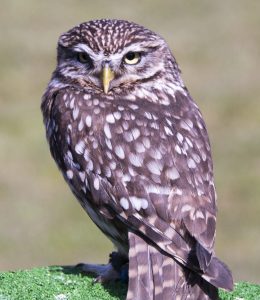
7. Screech Owls
In the United States, there are three different kinds of Screech owls. They are:
- Whiskered Screech owl
- Western Screech owl
- Eastern Screech owl
Despite their name, Screech owls do not actually screech. Some of their sounds are a bit screechy, but mostly they have a variety of calls that they use to communicate when they are active at night.
Western Screech owls are found in the Western United States, while the Eastern Screech owl is found in almost all the Eastern and Central United States. Whiskered Screech Owls are frequently found in the same areas as Western Screech owls.
As far as their habitat, Screech owls like forested areas near bodies of water like rivers and streams. In some areas, you can attract Screech owls by setting up nest boxes. They like to eat mice, snakes, lizards, and other smaller birds making them appealing for homesteads.
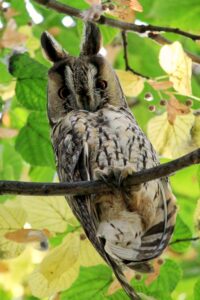
8. Long Eared Owl
Featuring massive tufts of feathers on the sides of its head, Long Eared owls constantly look surprised. This owl type is not a cavity nester. They prefer open nests. However, they do not build their own nests. Instead, they make use of the abandoned nests of other animals like squirrels or other birds.
Long Eared owls are incredibly shy, so many people have never seen one. However, their distinctive calls can be heard about a half mile away. They like to hunt on open ground, but nest in dense shrubbery. Long Eared owls will live in most parts of the United States, but their breeding grounds are in the Northern US and Canada.
9. Northern Pygmy Owl
An owl that is commonly seen because it is active during the day, the Northern Pygmy owl is commonly found in the western mountainous regions of the United States. The Northern Pygmy owl is a fairly small owl. It is not much larger than a sparrow. It waits patiently, awaiting the chance to snatch up its prey.
These birds eat mostly lizards, insects, and small birds, as well as small rodents. They nest in naturally occurring cavities and refuse to nest in man-made structures. Generally, the Northern Pygmy owl prefers thick forests that have some open spaces nearby where they can stalk prey.
10. Elf Owl
The Elf owl is the smallest owl type. These owls are about the size of a sparrow. Elf owls measure around 5 inches (13cm) in length and weigh 1.2 – 2 ounces (35 to 55 grams). Found in Texas as well as in the deserts of the Southwestern United States and in Northern Mexico, the Elf owl feeds on insects, centipedes, moths, and other invertebrates of the desert.
They fly silently, attacking their prey under the cover of darkness. The silent flight is made possible by the kinds of feathers that are found on the leading edge of their wings.
Elf Owls are active mostly at night, and they nest in cavities found in old hollow trees and cacti. If you capture an elf owl, they will play dead until they are released.
11. Burrowing Owl
One of the most unusual kinds of owls, burrowing owls live underground in tunnels they have dug themselves. These owls have long legs. They hunt during the day on the ground. They live in open areas like grasslands, prairies, and deserts, searching for insects, rodents, or small birds.
Burrowing owls live in the Western prairies and deserts. They also have healthy colonies in Southern Florida. They want spaces that have plenty of open ground.
Burrowing owls are unusual in that they create underground stashes of their prey. Scientists have found burrows containing hundreds of dead mice that the Burrowing owl had saved for another day.
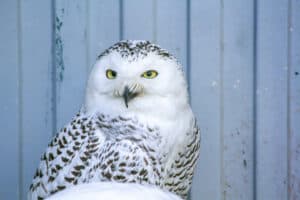
12. Snowy Owl
Pure white and one of the most eye-catching owls, when you see a Snowy owl, it is quite clear how they got their names. Because of their coloring, it is no surprise that Snowy owls live in places that get plenty of snow, such as in Alaska, North Dakota, South Dakota, Montana, and the Great Lakes region. However, if the United States experiences an unusual weather pattern, Snowy Owls may make their way as far south as Texas!
Snowy owls often hunt during the day, so they are spotted fairly frequently in the areas in which they live. They like wide open fields and shorelines where they can dive bomb their prey from above. These owls protect their breeding grounds fiercely, often returning to the same area to build their nests year after year.
13. Northern Saw-Whet Owl
The name of this owl can fool you. The Northern Saw-Whet owl can be found in most parts of the United States, not just in the north. However, these cute little owls do migrate to northern areas for breeding. These owls are one of the smallest owls on the planet.
These small owls nest in dense wooded areas, building their nests in the highest trees to give them a great view of the surrounding countryside. They are cavity nesters and will nest in abandoned holes in trees. The Northern Saw-Whet has a distinctive cry that can be heard at night because they are mostly nocturnal animals that feed on mice, insects, and small birds.
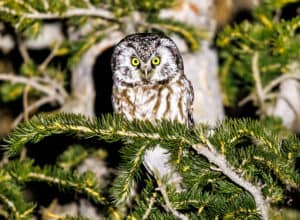
14. Boreal Owl
Active only at night, the Boreal owl lives in the exact place you would expect it to be found–the boreal forests of North America. They tend to stick to the most extreme northern reaches of the continent, which means that if you want to see a Boreal owl in the United States, you will probably need to travel to Alaska, Washington State, or Idaho.
These owls dive-bomb their prey, which consists mostly of rodents found in the forest. Boreal owls are cavity dwellers, and they will readily build a nest in a man-made nest box. If you live in its range, you may want to try putting up an owl box, and you may get lucky.
Boreal owls roost in a different tree every day. They like to sit quietly in tall coniferous trees during the daytime, about 15 to 20 feet above the ground.
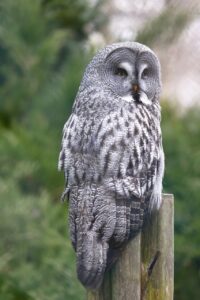
15. Great Grey Owl
An owl that values its privacy, the Great Grey owl seems to be elusive to many bird watchers. They are very shy, and their habitat within the United States is limited to the boreal forests in isolated mountainous regions of the United States. This is another type of owl that isn’t a cavity nester nor do they build their own nests. Instead, they use old nests from other birds, etc.
These owls are the tallest owl in the states, but it is mostly feathers since they weigh less than the Great Horned owl and the Snowy owl. These owls are strong, powerful birds that eat a lot, needing about 7 or 8 large voles to keep up their strength each day. They generally hunt at daybreak and at dusk.
16. Flammulated Owl
Flammulated means “flame-shaped,” and when you see the Flammulated owl, you will understand why it got its name. The coloring of the Flammulated owl’s plumage looks like an ash-covered log.
They are different from most other owls because they mostly eat insects. This means they use their eyes more than their ears to find food in the dark. They don’t need to listen as carefully when they are hunting.
Flammulated owls live in the very tops of the highest trees, preferring coniferous forests. They will sometimes live in deciduous forests, provided there are some conifers present. They nest in the cavities of trees, raising their young with no nesting materials in the cavity.
Flammulated owls live in isolated pockets of the Western United States and in the Southwest as well. They are very small, and most of their diet consists of insects.
One unusual feature of the Flammulated owl is that they have a call that is out of proportion for their size. Despite their miniature appearance, the Flammulated owl’s call is deep and throaty, the call of a much larger bird.
Different Kinds of Owls
If you live in an area with dense vegetation or lots of trees, you may already have some of these predatory birds on your property and not even know it. Most are nocturnal while some hunt during the day.
There are many types of owls. They all will feast on pests — helping control the rodent population — and smaller wildlife. Some will prey on chickens and other animals you raise.
Some smaller types of owls are cavity nesters. Larger owl species will tend toward large nests abandoned by larger birds, such as hawks. They will also favor the tops of broken trees, called snags.
One thing is for sure, owls live throughout North America, from Canada to Mexico and all throughout the United States. While most people consider owls to be an asset around their home and property, if you raise chickens or other livestock, or have small pets, you may want to learn how to keep owls away.

